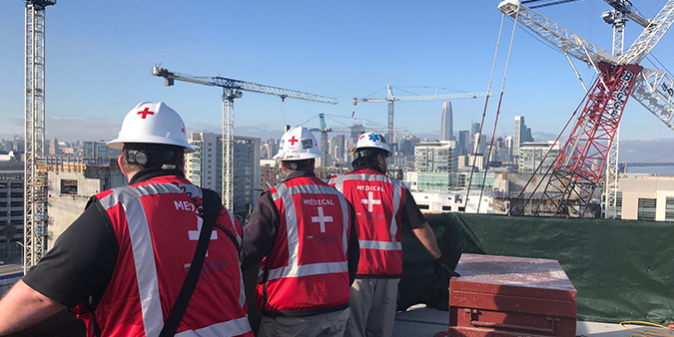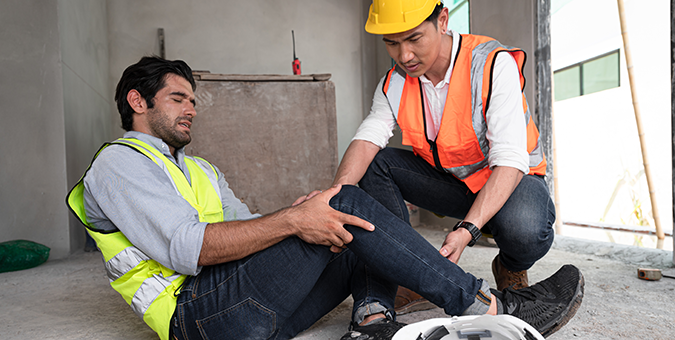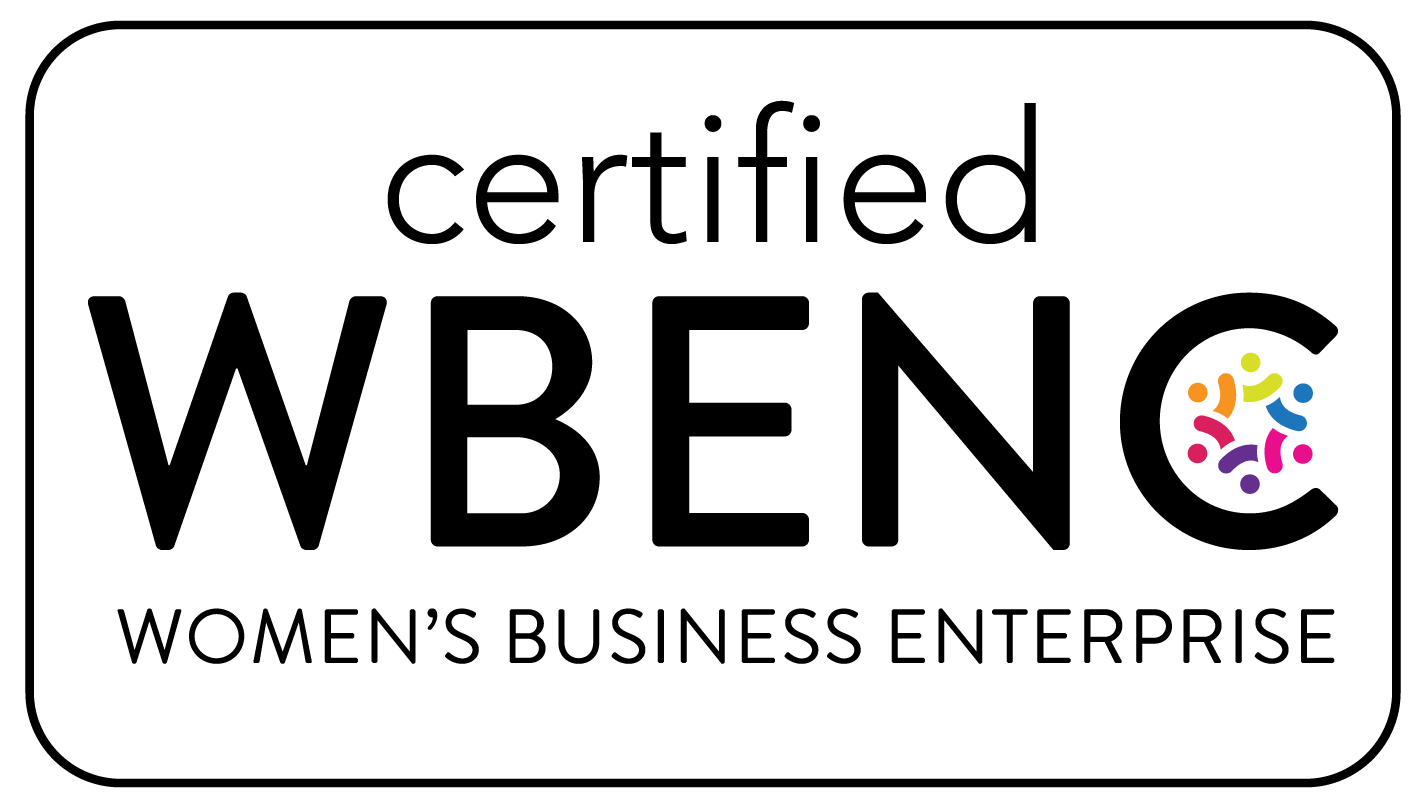Building an Effective Occupational Health Program in Construction

Discover the key components of an occupational health program in construction & what your business should look for to form a successful partnership with a vendor.
Author: Joseph Christian
May 7, 2025
Construction is a high-risk industry where workers face hazards like falls, heavy equipment strikes, and unguarded machinery daily. While workforce training is a vital step to prepare workers for the situations they will face, construction organizations need a robust and effective occupational health program to comprehensively address injury prevention and properly address injuries when they do occur.
An Effective Occupational Health Program Helps:
Reduce injury and accidents
Achieve better outcomes for injured employees
Increase productivity and limit unnecessary days away from work
Support compliance with OSHA requirements (federal, state) for injury prevention and care
Provide quality care that values employee health and helps improve employee retention
But what makes a successful occupational health program? What should a construction company look for in a vendor? Read on to find out.
Key Components That Create an Effective Occupational Health Program
A well-rounded occupational health program is more than injury care – it should take a comprehensive approach and include screening support, injury prevention, flexible on-site care, and support of mental health and well-being.
Screening Support
Construction sites have enough inherent hazards, which is why employee screening is vital to avoid further hazards caused by illegal substance abuse or environmental factors that can cause hazards for workers.
A vendor should be able to support drug and alcohol testing, such as random, post-accident, and reasonable suspicion testing. The point of these tests is not to punish but rather to ensure the safety of all workers on a site. This is vitally important in construction, where heavy equipment is commonplace.
Additionally, you want a vendor with medical surveillance screenings available – as needed due to the environmental conditions of a site.
Injury Prevention Services
While injuries will occur – they are not inevitable. A successful occupational health program will be able to identify and address injury risks before they cause injuries. In fact, like other physically demanding industries, many injuries in construction are musculoskeletal in nature and preventable.
The best way to address these risks is a comprehensive injury prevention program that includes the following parts.
Ergonomic assessments/recommendations
Conduct ergonomic assessments & recommend adjustments to reduce the risk of injuries.
Physical Demands Analyses & testing
Develop and administer job-specific physical demands testing based on comprehensive physical demands analyses to ensure your workforce can perform their job duties safely.
Stretching and strengthening programs
Evaluation of injury trends and job tasks allows for a targeted stretching and strengthening program.
Customized job conditioning
Enhance employees’ fitness levels and improve their resilience to the physical and ergonomic stresses of their job duties.

Immediate Onsite Medical Care
When injuries occur, it is important to have qualified occupational medical professionals onsite to triage and treat the injury as quickly as possible. Timely and appropriate care that follows regulatory OSHA requirements and best-practice AECOM guidelines will:
Lead to better injury outcomes
Give employees peace of mind that their health is a top priority
Reduce the negative effects of traveling for care – including wasted time and delayed injury care
The type of medical professional needed at a construction site will vary depending on the scope and needs of a particular location.
Generally, most sites will have a trained paramedic, often called an Occupational Health Technician (OHT) or a more specialized Musculoskeletal Intervention Specialist (MIS), assigned to them to triage and care for first-aid injuries onsite. Smaller sites or sites with a low-risk level can also offer TeleNurse Triage services. Additional medical professionals and virtual care options can be provided based on the needs of a site. (We will explore this more later in this blog.)
Successful onsite care in construction is the combination of a few key elements including:
Medical professionals partnering and working together with an organization’s existing health and safety team. Without a collaborative approach – gaps will reduce the effectiveness of outcomes
Matching care with the needs of a particular site
Having procedures in place that ensure OSHA compliance and employee well-being
Mental health and wellness
Unfortunately, the construction industry has one of the highest suicide and substance abuse problems of any industry.
Fifty-six out of every 100,000 male construction workers died by suicide in 2021, compared to 32 per 100,000 male workers in all industries. (Centers for Disease Control and Prevention)
Around 15% of all construction workers in the United States have a substance abuse disorder compared to 8.6% of the general population of adults. (American Addiction Centers)
Because of these concerning facts, a well-rounded occupational health program for construction must be able to address mental issues and substance abuse.
This goes back to prevention and taking time to raise awareness about suicide and substance abuse while working to change negative perceptions about expressing and addressing these struggles.
A great tool that is widely available is Mental Health First Aid (MHFA), which provides employees with tools to better identify, understand, & respond to signs of mental health & substance use challenges. Learn more by reading this blog [link]
Three Qualities to Look for In an Occupational Health Vendor
#1: Comprehensive Services
Construction projects have a lot of variables in scope, location, and requirements, which is why it is best to search for an occupational health vendor that can meet your needs with a comprehensive service offering available wherever projects may take you. Here are some details to look for:
All Care Modalities:
Your ideal vendor should offer all the various care modalities needed for effective occupational healthcare at a construction site. Beyond on-site care, you should also look for virtual care options, medical surveillance, and even the ability to have mobile care for multiple worksites in a geographic area.
One-Stop Shop:
Choose a vendor that has a single solution that includes healthcare services, employee screening, and workforce training. This approach helps streamline your occupational health program while saving time and resources.

#2: Flexibility and Accessibility
Effective communication and customization are essential in an occupational health vendor. Here are some things to look for:
Accessibility:
The vendor should be easy to reach and communicate with, especially during emergencies or when questions arise. This accessibility ensures you can quickly get the support and information you need.
Customization:
One size does not fit all in occupational health. Your vendor should be willing and able to customize their services to match your specific needs and circumstances. This could involve tailoring services, adjusting billing structures, or accommodating unique workplace challenges.
Integration:
A responsive vendor integrates seamlessly with your team. They collaborate with your existing EH&S professionals, HR departments, and managers to ensure a unified approach to employee health and safety.
#3: Construction Industry Experience and Proven Track Record
You need a vendor who knows how to best deploy occupational health solutions for construction.
You need a partner who is well-versed in OSHA requirements and the impact care metrics like recordables and lost time have on project goals and even how these metrics can affect future job bids.
Additionally, make sure the vendor you choose has a proven track record with construction projects and can meet the needs and goals of your projects. Choose a partner that knows how to keep and treat up to 96% of work-related injuries onsite with first aid, even for a massive construction project.
CAREonsite Can Help
Need help evaluating our occupational health program? Looking for a vendor that can prioritize the unique needs of your construction sites across multiple states. Talk to the experts and CAREonsite to learn how our experience can help you.
- careonsite
- Construction
- Customized job conditioning
- EH&S
- Ergonomic assessments
- health and safety
- health and safety programs
- health outcomes
- injury management
- injury prevention
- mental health
- musculoskeletal injuries
- Musculoskeletal Intervention Specialist
- occupational health
- occupational health program
- Occupational Health Technician
- occupational healthcare
- OSHA requirements
- Physical Demands Analyses
- safety
- Screening Support
- Substance Abuse
- suicide
- Tang+Company
- work-related injuries
- worker safety

